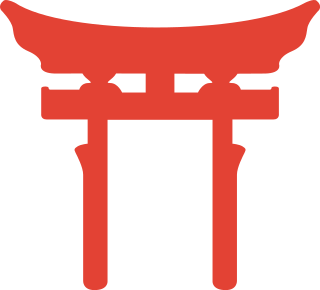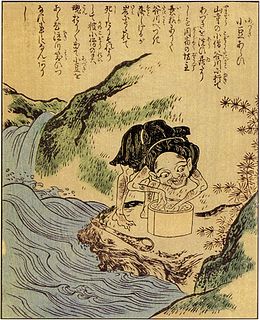
Emperor Jimmu was the first Emperor of Japan, according to legend. His accession is traditionally dated as 660 BC. According to Japanese mythology, he is a descendant of the sun goddess Amaterasu, through her grandson Ninigi, as well as a descendant of the storm god Susanoo. He launched a military expedition from Hyuga near the Inland Sea, captured Yamato, and established this as his center of power. In modern Japan, Jimmu's accession is marked as National Foundation Day on February 11.

The Kofun period is an era in the history of Japan from about 300 to 538 AD, following the Yayoi period. The Kofun and the subsequent Asuka periods are sometimes collectively called the Yamato period. This period is the earliest era of recorded history in Japan, but studies depend heavily on archaeology since the chronology of historical sources tends to be distorted.

The Nihon Shoki (日本書紀), sometimes translated as The Chronicles of Japan, is the second-oldest book of classical Japanese history. The book is also called the Nihongi. It is more elaborate and detailed than the Kojiki, the oldest, and has proven to be an important tool for historians and archaeologists as it includes the most complete extant historical record of ancient Japan. The Nihon Shoki was finished in 720 under the editorial supervision of Prince Toneri and with the assistance of Ō no Yasumaro dedicated to Empress Genshō.

Astara is the southernmost rayon in southeastern Azerbaijan.

Shamkir is a rayon in Azerbaijan. It is located in the northwestern part of the Azerbaijan Republic. The rayon was previously called "Shamkhor" during the Soviet rule and was renamed to Shamkir only in 1991 after restoration of independence of Azerbaijan. The district was established in 1930. The capital of Shamkir Rayon is Shamkir city.

Karki or Tigranashen is a village that is de jure an exclave of the Nakhchivan Autonomous Republic of Azerbaijan. The village is near the border with Armenia, located on the bank of the Arpachay River near the Yerevan-Jermuk highway, which is 15 kilometres (9.3 mi) away from the district center. The area of the village itself is 950 hectares. Karki is de jure within the administrative territory of the Sadarak Rayon of Nakhchivan. It was occupied on January 19, 1990, by Armenian forces.

Azukiarai, or Azukitogi, is a ghostly phenomenon in Japanese folklore, in which a mysterious noise that sounds like azuki beans being washed or ground is heard. It usually occurs near a river or other body of water. Sometimes the creature or spirit responsible amuses itself by singing "azuki togou ka, hito totte kuou ka? shoki shoki.", and anyone who approaches will inevitably fall into the water.

The Tsakhur or Caxur people are an ethnic group of northern Azerbaijan and southern Dagestan (Russia). They number about 30,000 and call themselves yiqy, but are generally known by the name Tsakhur, which derives from the name of a Dagestani village, where they make up the majority.

Artsvashen, also Romanized as Artzvashen, is an exclave of Armenia's Gegharkunik province which has been occupied by the Azerbaijani army since 1992. The official Azerbaijani name for the village is Başkənd. Its size is about 40 square kilometres, and it is completely surrounded by the territory of Azerbaijan and has been controlled by it since the Nagorno-Karabakh War. Today, the village is mostly inhabited by Azeris as the Azerbaijani army expelled its Armenian population after it seized the territory and is now administered by Azerbaijan as part of Gadabay Rayon.
Shoki or Shōki may refer to:

Hat'ērk or Hasanriz is an old Armenian village in the Mountainous Karabakh. According to the jurisdiction of the unrecognized Nagorno Karabakh Republic, which controls the village, it is in Martakert region of NKR. According to the jurisdiction of Azerbaijan, the village is in the Kelbajar region of Azerbaijan. According to the census in 1987, the village had population of 1527 people, all Armenians. It was one of the Capitols of the Principality of Khachen, a Principality that existed from 1261-1603 when the region was broken up into a feudal Armenian/Azeri Persian Khanate.

Coni is a village and municipality in the Lerik Rayon of Azerbaijan. It has a population of 421. The municipality consists of the villages of Coni and Tülü.

Günəşli is a village and municipality in the Lerik Rayon of Azerbaijan. It has a population of 1,022. The municipality consists of the villages of Günəşli and Babagil.

Noda is a village and municipality in the Lerik Rayon of Azerbaijan. It has a population of 1,215. The municipality consists of the villages of Noda and Aşağı Bilnə.

Dzhigli is a village in the Quba Rayon of Azerbaijan.

Khodzham Saqly is a village in the Qubadli Rayon of Azerbaijan.

Dashalfy is a village in the Qubadli Rayon of Azerbaijan. Dashalfy is the Azeri village in Qubadli

Amenohiboko (天日槍) was a legendary prince of Silla who settled in Japan during the era of Emperor Suinin, around the 3rd or 4th century and was said to have lived in Tajima Province. His descendants are Tajima clan. Amenohiboko is the ancestral god of Tajima Province and is supposedly enshrined in the Shinto Shrine at Toyooka in Hyōgo Prefecture.

Zandabad is a village in Owch Hacha Rural District, in the Central District of Ahar County, East Azerbaijan Province, Iran. At the 2006 census, its population was 1,104, in 224 families.
Nakhchivan or Nakhichevan may refer to:














